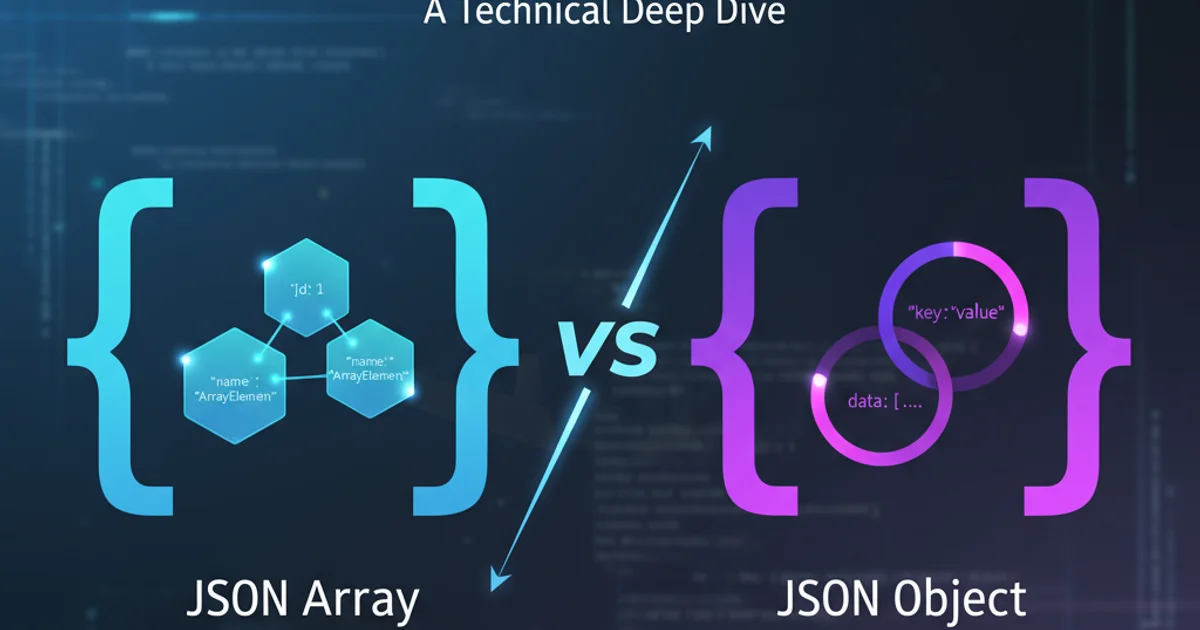What are the differences between using JSON arrays vs JSON objects?
Categories:
JSON Arrays vs. JSON Objects: Understanding the Core Differences

Explore the fundamental distinctions between JSON arrays and objects, their use cases, and how to choose the right structure for your data.
JSON (JavaScript Object Notation) is a lightweight data-interchange format that is easy for humans to read and write, and easy for machines to parse and generate. It is built on two fundamental structures: arrays and objects. While both are crucial for organizing data, they serve distinct purposes and have different structural characteristics. Understanding when to use an array versus an object is key to designing efficient and logical data structures.
JSON Objects: Key-Value Pairs for Unordered Data
A JSON object is an unordered collection of key-value pairs. Each key must be a string, and it must be unique within the object. The value can be any valid JSON data type: a string, number, boolean, null, another object, or an array. Objects are ideal for representing entities with distinct properties, where each property has a meaningful name. Think of them as dictionaries or hash maps in programming languages.
{
"firstName": "John",
"lastName": "Doe",
"age": 30,
"isStudent": false,
"address": {
"street": "123 Main St",
"city": "Anytown"
},
"courses": ["History", "Math"]
}
Example of a JSON object representing a person's data.
"key").JSON Arrays: Ordered Lists of Values
A JSON array is an ordered collection of values. Unlike objects, arrays do not use named keys; instead, values are accessed by their numerical index, starting from zero. Arrays are best suited for lists of similar items, sequences, or when the order of items is significant. Each value in an array can be of any valid JSON data type, including other arrays or objects.
[
{
"name": "Apple",
"color": "Red"
},
{
"name": "Banana",
"color": "Yellow"
},
{
"name": "Orange",
"color": "Orange"
}
]
Example of a JSON array containing multiple fruit objects.
Key Differences and Use Cases
The primary distinction lies in how data is identified and structured. Objects use descriptive string keys, making them ideal for representing single entities with multiple properties. Arrays use numerical indices, making them perfect for lists or collections of items where the order might matter or where you need to iterate through similar data points.
flowchart LR
A["JSON Structure"] --> B{"Has Named Properties?"}
B -- Yes --> C["JSON Object"]
C --> D["Unordered Collection"]
C --> E["Key-Value Pairs"]
B -- No --> F["JSON Array"]
F --> G["Ordered Collection"]
F --> H["Indexed Values"]
D --> I["Represents a single entity (e.g., User, Product)"]
G --> J["Represents a list of items (e.g., Users, Products)"]Decision flow for choosing between JSON Object and JSON Array.
Consider a scenario where you're storing information about a single book versus a library's catalog. For a single book, an object is appropriate:
{"title": "The Great Gatsby", "author": "F. Scott Fitzgerald", "year": 1925}
For a library's catalog, an array of book objects would be suitable:
[ {"title": "Book A", "author": "Author X"}, {"title": "Book B", "author": "Author Y"} ]
Nesting JSON Structures
Both arrays and objects can be nested within each other, allowing for complex and hierarchical data structures. This flexibility is what makes JSON so powerful for representing diverse data models.
{
"libraryName": "City Central Library",
"books": [
{
"title": "1984",
"author": "George Orwell",
"genres": ["Dystopian", "Political Fiction"]
},
{
"title": "Brave New World",
"author": "Aldous Huxley",
"genres": ["Dystopian", "Science Fiction"]
}
],
"staff": {
"manager": "Jane Doe",
"librarians": [
{"name": "Alice", "id": "L001"},
{"name": "Bob", "id": "L002"}
]
}
}
A complex JSON structure demonstrating nested objects and arrays.